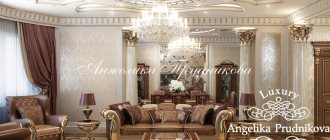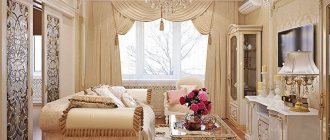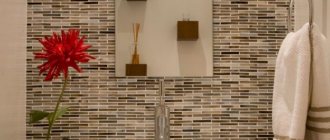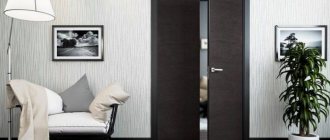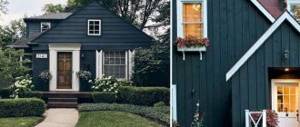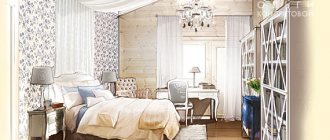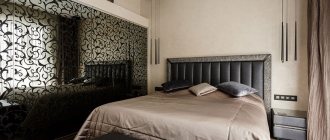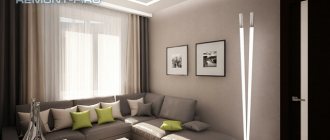Advantages and disadvantages
First, let's look at the features of white color in wall design:
| Advantages | Flaws |
| Designers joke that white does the job for them, adding space and air. Therefore, it is considered a win-win option. | If you use cheap paint, the walls will take on a greenish “hospital” tint. Therefore, the material needs to be tinted at least a little. |
| Creamy, pearl and snow-white shades serve as an excellent backdrop for furniture and decor. | Despite its external simplicity, white is one of the most complex colors, requiring special attention to finishing during renovations and order in the house. |
| Light colors give a feeling of freshness and comfort. | Not suitable for those who associate it with sterility and facelessness. |
Shades of white
White color has several incarnations. Snow-white with blue and green tints is more suitable for rooms with windows facing south. Smoky white looks cool as it has a gray undertone, but at the same time gives the interior a cozy and calm feeling. Unfortunately, in dark, north-facing rooms, smoke appears off-white, so its use in poorly lit rooms is not advisable. Cold shades also include snowy (perfect white), which adds brightness to the room.
The photo shows a small bedroom with white walls that visually expand the space.
Warm tones include white walls with yellow and pearlescent shades: the color of “natural linen”, creamy, “sea shell”, “honeydew”. The cream (milky) shade of the walls is especially popular. The temperature of the ivory color depends on the lighting, but its nobility remains unchanged.
Warm tones are best suited to classic and rustic interiors, while cool tones are best suited to modern, industrial and minimalist interiors.
The photo shows a living room-library in warm cream tones.
White wall color for bright accents
Many people love white for its ability to visually expand the space of a room or an entire apartment, as well as its ability to reflect colors. In addition, by decorating the walls in white, you can easily and quickly change your mood in the interior, changing or adding new bright accents. An important advantage of white is its unique compatibility with all other colors. It's like a blank slate, ready for any changes - a great way for those who like to periodically change their interior. Moreover, these changes will not lead to large-scale, expensive repairs. To transform rooms, all you need to do is change the colors of textiles and some existing decorative elements (paintings, floor decorations, etc.).
Bright accents in a bright interior with white walls
In this case, light walls will also serve as a calm background. And the main bright accents will be provided by these decorative items. Thus, home flowers or colored sofa upholstery will attract attention if they are placed against a white wall. Textiles that decorate the room include carpets of any size, curtains and curtains for windows, pillows, a blanket on an armchair, a tablecloth on a table, and colored upholstery on chairs. On a white neutral background, all bright elements will look more expressive, although you don’t need to get carried away so that the entire interior does not look tacky. For a harmonious interior on a white background, you should not use the entire palette of colors. One or maximum two colors that can be combined with each other as bright accents would be appropriate.
Best combinations
White wall color is universal, so it looks harmonious with most shades. Serious and uncompromising natures will like the monochrome furnishings - a contrasting combination of black and snow-white. This is a traditional option, giving an atmosphere of rigor and respectability, even if little money was spent on renovations.
Nature lovers will appreciate the combination of pearl, green and wood. This solution is relevant for Scandinavian and eco-style: light walls bring furniture and decor made from natural materials to the fore.
The milky color also makes an excellent background for bright details: yellow accessories make the atmosphere joyful and sunny, while red ones emphasize the courage and originality of the apartment owner.
The photo shows a living room with white walls and a black accent area in the TV niche.
The white color of the walls in the interior looks great in combination with calm beige and luxurious gold, giving the living room or bedroom sophistication.
Cool blues, aqua and mint tones are suitable for nautical-style rooms, as well as modern interiors that want to add freshness and airiness.
The combination of white and gray is considered a winning one: this option never goes out of fashion, and it is also easy to dilute with splashes of color.
The photo shows a living room with white walls, which recedes into the background, highlighting the original furniture and a magnificent fireplace.
White brick wall in the interior
By emphasizing various details, in many cases white walls act as a background solution. However, a white wall in itself can become a decoration and take a central place in the interior if it is made of decorative brick. Popular for loft style interiors. Currently, the use of stone or brick in the interior decoration of a house or apartment is becoming a very popular trend. Moreover, either a whole wall or a separate part of it, a corner, a column or an entrance opening can be used as a decorated surface. A white brick wall will not only be an original decoration, but also a very practical finishing option, which is especially appropriate for the kitchen. This design method will look great, highlighting a dining area with a table and chairs or a formal area in a hotel room. A significant function of a white wall is to visually enlarge the space, making it more spacious and bright. However, you should be careful with brick trim, even in white. To prevent such a room from becoming gray and dull, you need to take care of the lighting design in advance.
Related article: DIY installation of infrared (film) heated floors
A wall decorated with white brick can be used in many styles, even classic. You just need to properly arrange and decorate the room. But, white finishing brick will look most advantageous in the interior of modern styles: loft, minimalism, hi-tech.
What curtains are suitable?
Another irrefutable advantage of white walls in the interior is their versatility. You can change textiles - curtains, bedspreads, pillows - and the room will be transformed without much expense.
When purchasing curtains, consider the three-color rule. Since white is the main color of the room, you need to choose curtains either as an additional shade (it takes up 30% of the room) or as an accent (10%).
The design of curtains depends on the chosen direction: multi-tiered curtains will fit into a classic style, and laconic curtains will fit into any modern one. As for patterns: they are appropriate if the environment is not active, that is, white wallpaper or furniture upholstery should not contain ornaments. A successful pair is the same curtains and pillows.
In the photo there are soft beige curtains that soften the bright whiteness of the living room.
An excellent option is dark, plain curtains in rich colors that will make the interior lively and modern.
If you hang curtains that are identical in color to the walls, this will add light and sophistication, but there is a risk of creating a dull interior. This solution looks impressive if the rest of the room is designed in white tones.
The photo shows a small bedroom with pure white walls, light textiles and matching furniture.
Advantages of white walls in an apartment
01 The option of white walls in an apartment is considered by many as too simple, boring, uninteresting, and too impractical, soiled. White walls - what is the design here, what is the idea? Whether it's colored painting, textured plaster, matting, imitation brick, or wallpaper with an intricate pattern! However, this opinion is more than erroneous, and in fact, white walls are one of the most beautiful and practical design finds.
03 Let's start with the fact that modern paints “repel” excess dirt, are easy to wash, and do not change color under the influence of time and sunlight.
In addition, white color does not need to be perceived unambiguously. White color is not a single color, white has many shades, a whole range, from cold to warm. So for every taste and for every interior there is a white color option. Well, if we talk about beauty and benefits, then white walls in the interior have many advantages in this regard:
04 1. Increasing illumination .
White light is similar to a spotlight - it greatly increases the illumination of the apartment due to the reflection of light, and brightens dark corners. In an interior with white walls, additional sources of lighting seem to appear. This is especially important in apartments where the windows face north, or are heavily obscured by trees or other buildings. The “lighting” properties of white color are of particular importance in late autumn and winter, when there is especially little light in any room: they set you in a positive mood and prevent seasonal depression from developing.
05 2. Increase in area. White always enhances the visual appearance.
So in the interior, white color can significantly expand the boundaries of any room, thereby increasing its area and volume perceived by the eye. Even the smallest room, decorated in white, can seem spacious. And this has a physical explanation: our eyes are accustomed, according to the laws of aerial perspective, to perceive light as being further away from us. Also, white color is also an additional light, and light also further increases the space.
06 3. Universal compatibility .
White color is universal: in fact, it is the sum of all existing colors. It goes with any decor, any interior style, and with any color that is used in this very interior. Walls of any other color, and especially those covered with wallpaper with a certain pattern or texture, are already obligatory, limiting, since they set some kind of color and stylistic “theme”. Well, white is always good, with any companions. Any, even not the most successful color, in combination with white will look more dignified. Moreover, if you decide to introduce very bright details into the interior, white color will slightly cool the brightness of the colors, allowing you to live comfortably even in a very bright experimental interior.
07 4. Potential for change .
Since white color is a universal “soldier”, it allows you to change the design of your interior as often as you want, without prior preparation. Any textiles, furniture and accessories will look great against a white background, and this is known in advance, there is no risk! If you want, you can change your interior every season, or if you want, you can change it at least every month. The result is guaranteed. You don't have to be afraid to buy any new things for your home. They will definitely fit into an interior with white walls!
02 5. Unlimited decor possibilities. The white walls themselves, in addition to being compatible with any accessories and decoration of the apartment, also themselves offer unlimited possibilities for decoration. White walls are like a white sheet of paper. That’s what you “write” on them. White walls can be painted, manually or using a stencil. One of the walls can be covered with beautiful wallpaper, upholstered with fabric, trimmed with wood, inscriptions in a beautiful font, or brightly painted - in contrast to the rest of the walls. Collections of paintings, photographs, or your handicrafts, as well as any wall decorations: panels, stucco, decorettos, will look great on white walls.
09 6. Interior catalyst .
White color has the properties of a catalyst - it enhances, highlights, emphasizes all colors and objects located on its background. Therefore, a background of white walls will effectively emphasize the style and color scheme of your room, the clarity or intricateness of lines and shapes, and will attract special attention to the original details. White color favorably presents everything that fills your interior; against any other background it would all look different, and much would be completely “lost.”
08 7. Psychological properties .
White color has certain psychological properties that are very important for us, namely: it creates the impression of freshness and purity, joy, at the same time calms and invigorates, and most importantly, it releases internal reserves. Isn't that what everyone wants?
10 8. Cosmetological properties . In addition to all of the above, white color also has a physical effect on the body, acting as a cosmetologist color. Other colors are used in cosmetology, but white is special. This color has a rejuvenating effect. It helps saturate the skin with moisture and maintain its elasticity. It should be noted that the effect of any influence is stronger, the longer it is carried out. Well, we spend much longer in our interior than in a cosmetologist’s office.
Finish options
A snow-white interior requires a choice of materials to suit every taste, but how can you make white walls in an apartment or house yourself?
The most budget-friendly and popular solution is emulsion paint. It is easy to care for and can be applied easily in one or two layers. The texture can be glossy (has a cool shine, but is easier to clean) or matte (better hides wall imperfections). If the surface gets dirty, you can simply repaint it. The only drawback is that the walls must be smooth and perfectly prepared.
Another design method is decorative plaster. It makes the interior more diverse, but the textured surface is more difficult to care for. In addition, during the next repair the coating will have to be cleaned down to the base.
Ceramic tiles are traditionally chosen for the bathroom. The gloss reflects light, so it is an ideal choice for small bathrooms. The tiles are environmentally friendly, durable and absolutely not afraid of moisture (which cannot be said about seams). It is also suitable for kitchen aprons, protecting walls from dirt.
The photo shows painted white walls that extend into the white ceiling of the attic. The kitchen backsplash is finished with boar tiles with dark grout.
A relatively inexpensive finishing method is paintable wallpaper (non-woven, vinyl, paper). They hide the imperfections of uneven walls well. But they need to be glued end to end so that the surface looks perfect.
Brickwork also never goes out of style. It is appropriate not only in the loft style, but also in Provence, fusion and Scandi. There are several ways to create a white brick wall:
- paint a natural terracotta wall, having previously cleared it of salts and primed it (then it will be practically impossible to remove the paint);
- forming bricks with plaster, then painting;
- buy gypsum tiles and glue them.
A less popular, but attractive way to decorate walls is wood: lining or panels. Not only country houses are clad in wood, but also apartments when you want to add a touch of country atmosphere to the decor.
What style is better to decorate?
White walls in a house or apartment mean, first of all, versatility. They add nobility to the classic style, combining perfectly with rich textures, luxurious furniture made of expensive wood and stucco on the ceiling.
White walls are the hallmark of a Scandinavian-style apartment. They are supported by homemade decorative elements, budget furniture, cozy textiles and home plants.
White walls in a loft-oriented interior add spaciousness to the room. In such industrial apartments, it is important to leave a light background: deliberately rough contents (furniture and decor) should be balanced with light, unobtrusive finishing.
The photo shows a living room-office in the loft style. The white color of the walls serves as a background for contrasting furniture, and the color of the floor emphasizes the brutality of the decor.
The milky shade invariably remains a favorite for the shabby chic style, which is appreciated by romantic people. Antique furniture, scuffs, fresh flowers and light textiles give a feeling of airiness and at the same time homely living.
In high-tech style, white wall color remains the most popular. With the help of lighting in different colors, a snow-white room can change its appearance depending on the needs of its owner.
White wall color for contrasting solutions
The white walls of an apartment or house can be completely painted/decorated in this color or partially. If the task for a room is to separate part of it zonally or select one wall to place a contrasting accent on it. Then, in this case, white color will be used as a smoothing background, which will not stand out, but rather will emphasize the “zest” of the interior. It would be appropriate to say “white goes with everything.” For example, to contrast one of the walls of the room by decoding it as wood, it would be better to make the remaining walls white or another light color so as not to overload the overall interior. This way you can combine lightness and brutality of the interior.
Related article: Thermal conductivity coefficient of materials
These style elements are partly borrowed from the very popular Scandinavian-style interior design. For many, this is the optimal combination of colors and textures in creating a cozy home interior.
How does it look in the interior of the rooms?
It is the white walls that help bring together “incompatible” interior items.
The photo shows a living room in a fusion style, where things with history are united by one common background. Wood, terracotta and turquoise details look interesting on it.
Also, the snow-white background emphasizes bright elements, and contrasting details look even more saturated. It adds graphics and rigor to black and brown colors.
The photo shows a living room with a neutral background, which makes the upholstery visually brighter.
The white color of the walls is appropriate both in a spacious apartment and in a small studio, where there is almost no empty space left. It increases light and visually blurs the boundaries between walls and ceiling.
White walls in a Scandinavian interior
Many experienced designers have noted in recent years a trend of increased interest in Scandinavian interior design for a home or apartment. The principles of this style are based on simple and understandable solutions:
- predominance of light colors, predominantly white;
- maximum illumination;
- natural accents (particularly wood) and natural materials.
Scandinavian interior suggests an abundance of light and white (semi-white) tones in combination with natural materials. Snow-white walls will create lightness and weightlessness in the interior of the rooms. They can be decorated with all kinds of paintings, posts, photographs in photo frames hanging on the wall or unusual decorative items in the form of skins, theater masks, etc.
The presence of good light is achieved through proper window decoration. White walls harmonize perfectly with the whitewashed floor and light frames on the windows. As a rule, the Scandinavian interior is characterized by a complete absence of textiles on the windows or its presence in a minimal amount. For this, light, light curtains that let in the maximum amount of light or always assembled Roman blinds, which are used only for decorating windows, are suitable. This interior uses numerous lamps of laconic, restrained shapes. As well as contrasting colors in other items for additional lighting: floor lamps, sconces and sometimes candles.
The use of wood in combination with light white tones brings us closer to nature, creates unique comfort and warmth in the overall atmosphere of the house. This could be wooden furniture with raw details, for example, rough uncouth bookshelves or cabinets, a wood coffee table. It would be appropriate to lay parquet boards or laminate on the floor. Also, wickerwork will fit well into this interior: from small items (baskets and vases) to large-sized furniture (chairs, tables).
Related article: Joining tiles and laminate - do it beautifully
When creating a Scandinavian interior in your apartment, remember one simple thing - the main thing is not to overdo it with wood, just like in any other interior with other contrasting elements. Because this interior style involves an abundance of white, diluted with natural decor, and not vice versa.
